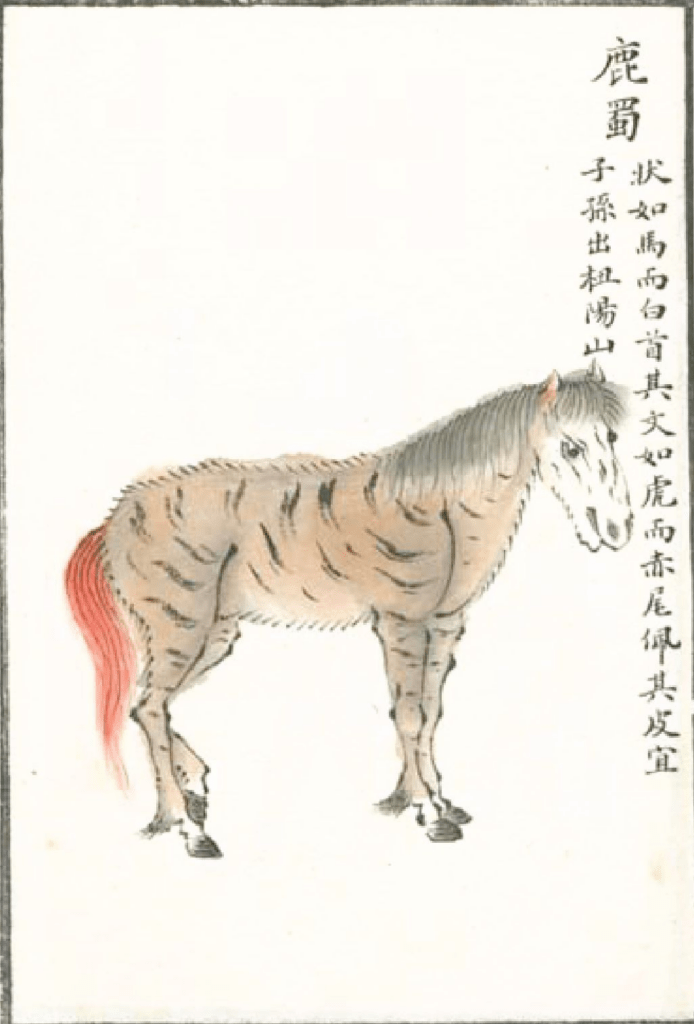
Lushu Mythology in “Classic of Mountains and Seas“
In Mount Niuyang, there is a kind of auspicious creature called the Lushu. Its body shape is similar to a horse, but it has a white head. Its body is patterned like a tiger, yet its tail is red. The sound it makes when it roars is like a person singing. It is said that whoever wears its fur will be blessed with many descendants.
《山海經 · 南山經》
杻陽之山,有獸焉,其狀如馬而白首,其文如虎而赤尾,其音如謠,其名曰鹿蜀,佩之宜子孫
Lushu folklore story
In ancient times, at the southernmost tip of China, there was a mountain known as Mount Niuyang. This mountain was home to a strange wild beast that resembled a horse in overall appearance. It had a white head, tiger-like stripes on its body, and a strikingly red tail that glowed like fire. However, its behavior was neither like a horse nor a tiger, but more akin to a deer. It spent its days merrily frolicking in the forest, emitting sweet, melodious sounds that were ethereal like bird songs and fluctuating like ballads. The birds and beasts of the forest believed it to be a spirit of the woods.
At the foot of Mount Niuyang, there was a human tribe. Generations of people had lived there, hunting in the forest and fishing in the river for their livelihood. One day, the forest spirit, Lushu, accidentally fell into a trap set by the tribe. Injured, its usually serene and joyful calls turned into a sorrowful ballad, echoing through the forest. The person who set the trap heard its song and discovered the injured spirit in the pit. Moved by its plaintive melody, the people couldn’t bear to harm it. They tenderly dressed its wounds with herbs and released it back into the forest.
The Lushu, touched by the kindness of these humans, plucked a tuft of its fiery red mane with its mouth and offered it to them as a gift before departing with a cheerful song. As it left, the dark forest lit up with a newfound brightness. The people, marveling at the beauty of the fiery red hair, which looked like burning threads, wore it with pride. However, they never saw the beautiful spirit again.
Not long after returning to their tribe, those adorned with the red hair noticed something miraculous: their wives were bearing children, not just one but many. This was an incredible event for the primitive, isolated tribe. As time passed, the tribe’s population began to grow exponentially, far surpassing other tribes.
They carefully preserved the red hair given by the Lushu and distributed it to newlywed women in the tribe. They firmly believed that the red hair symbolized the continuity of fire and an ever-increasing population. Thus, the legend of the Lushu and its gift of prosperity and fertility became an integral part of their heritage and culture.
In today’s Hainan Island in China, there is a legend called ‘Deer Looking Back.’ A Li ethnic youth chased a roe deer from Wuzhishan for nine days and nights, pursuing it all the way to the coast of the South China Sea. Suddenly, the roe deer stopped, stood at the edge of a cliff, and turned to look back at the Li youth. Its eyes were clear, beautiful, yet filled with a helpless and poignant sadness. Captivated by this scene, the youth was stunned and dropped his bow and arrows. The sky brightened with colors, and in an instant, the roe deer transformed into a beautiful Li ethnic girl. From that moment, they fell deeply in love.
Lushu in real world
Regarding the Lushu, scholars have proposed three possibilities:
First, the Lushu might be a zebra. This is because zebras have tiger-like stripes on their bodies. However, some scholars argue that zebras lack one feature: they definitely do not have a red tail like the Lushu.
Second, the Lushu might be a Okapi . Like the zebra, the Okapi also originates from Africa, and its appearance matches the description of the Lushu in the ‘Classic of Mountains and Seas.’
Third, the Lushu could be a Quagga. This is the most convincing theory. It’s a subspecies of the zebra, with a white head, clear tiger-like stripes on its upper body, and a brownish rear half. It has strong, endurance-capable limbs. Originating from Africa, it is now extinct.
Other Page: Chang’e: Chinese Goddess Flying to the Moon

Comments are closed.